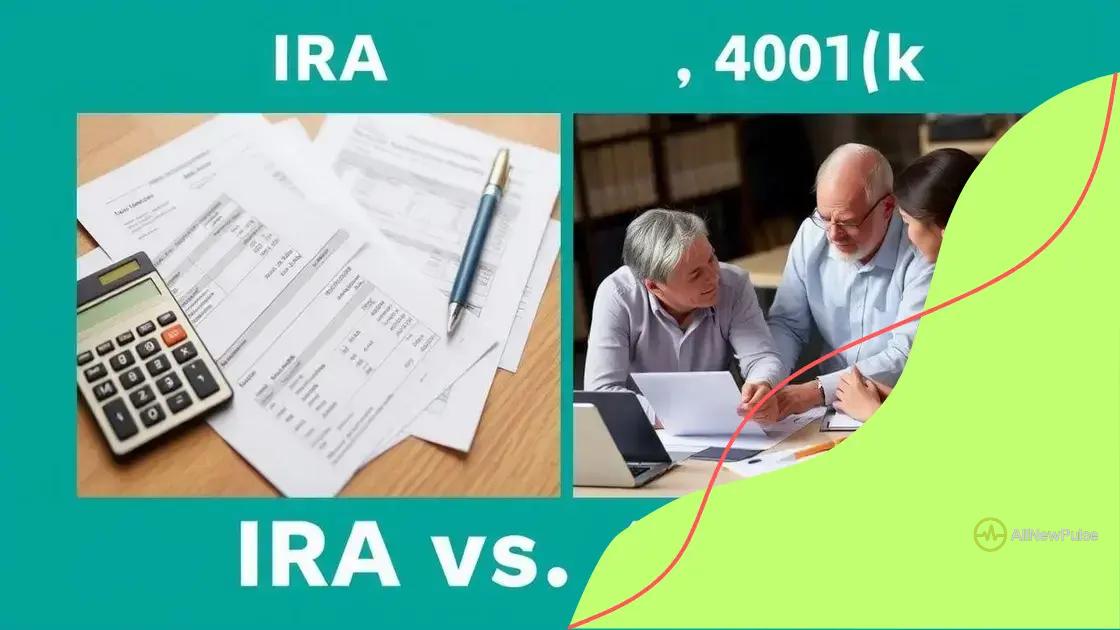Understanding various retirement savings account options

Understanding various retirement savings account options is crucial for maximizing your savings, with choices like 401(k)s, IRAs, and Roth IRAs each offering unique benefits tailored to individual financial goals.
Understanding various retirement savings account options is essential for anyone planning for the future. With so many choices available, how do you decide which ones suit your needs best? Let’s explore the options together.
What are retirement savings accounts?
Retirement savings accounts are designed to help individuals save money for their future after they stop working. Understanding these accounts is crucial as they offer various benefits that can enhance your financial security. But what exactly are retirement savings accounts, and how do they work?
Types of Retirement Savings Accounts
There are several types of retirement accounts, each with its own features and rules. Commonly known accounts include:
- 401(k): Offered by employers, this account often includes matching contributions, making it a popular choice.
- IRA (Individual Retirement Account): This account allows individuals to save independently, often with tax advantages.
- Roth IRA: Similar to a traditional IRA, but contributions are taxed upfront, providing tax-free withdrawals later.
- Simplified Employee Pension (SEP): This is ideal for self-employed individuals and small business owners, allowing for higher contribution limits.
These accounts not only help you save but can also provide potential tax benefits which can accelerate your savings growth. Investing early in these accounts can make a significant difference in your retirement funds.
How Do They Work?
Retirement savings accounts generally allow you to contribute a portion of your income. The contributions may be pre-tax or after-tax depending on the type of account. When you invest in these accounts, the money can grow over time through interest or investment returns, depending on the assets held in the account.
For instance, a 401(k) plan allows you to auto-enroll, making it easy to start saving without direct action each pay period. With an IRA, you have the flexibility to manage your investments more actively, choosing from a broader range of options.
Understanding how each type of retirement savings account functions can empower you to make informed decisions. It’s essential to analyze your situation and choose accounts that align with your financial goals.
In summary, retirement savings accounts serve as a valuable tool for individuals planning for their future. Taking the time to learn about them can lead to better financial outcomes and a more secure retirement.
Types of retirement accounts available
There are several types of retirement accounts available, each designed to help you save for your future. Understanding these options can provide significant advantages as you work towards financial security in your retirement years.
Common Types of Retirement Accounts
Each retirement account has distinct features that suit different needs. Here are some of the most common types:
- 401(k) Plans: These are employer-sponsored plans that allow employees to save a portion of their paycheck before taxes are taken out. Many employers offer matching contributions, which is essentially free money for your retirement.
- Traditional IRA: An Individual Retirement Account allows individuals to save money with pre-tax earnings. This means you don’t pay taxes on the money until you withdraw it during retirement.
- Roth IRA: With a Roth IRA, you contribute money that has already been taxed. This allows for tax-free withdrawals during retirement, which can be very beneficial depending on your tax situation.
- SEP IRA: Often used by self-employed individuals and small business owners, a Simplified Employee Pension allows higher contribution limits than traditional IRAs.
Using these accounts effectively can lead to significant growth in your savings. For example, having a 401(k) with employer matching can greatly enhance your retirement fund.
Choosing the Right Account
When it comes to choosing a retirement account, consider your personal financial goals. If you expect to be in a higher tax bracket in retirement, a Roth IRA might be beneficial. On the other hand, if you want to minimize taxable income now, a traditional IRA or 401(k) may be more suitable.
It is also important to look into the fees associated with each account. Some accounts may charge management fees that affect your overall returns. Being aware of these details helps you make better choices for your future.
As you consider your options, think about when you want to retire and how much money you will need. Each type of retirement account plays a role in reaching those goals.
Benefits of IRA vs. 401(k)

Understanding the benefits of an IRA compared to a 401(k) is essential for making informed retirement planning choices. Both accounts play significant roles in retirement savings, yet they have different features that can impact your financial future.
Flexibility in Contributions
One of the benefits of a 401(k) is that it often allows for higher contribution limits than an Individual Retirement Account (IRA). This means you can save more money each year, especially if your employer offers matching contributions. On the other hand, an IRA provides more options for investments, allowing you to choose from a wider variety of stocks, bonds, and mutual funds.
Tax Advantages
Both accounts offer tax advantages, but they work a little differently. Contributions to a 401(k) are made with pre-tax dollars, which reduces your taxable income for the year. With a Traditional IRA, contributions may also be tax-deductible, depending on your income and other factors. Alternatively, a Roth IRA allows you to withdraw your contributions tax-free in retirement, but you pay taxes on your contributions now.
- 401(k): Pre-tax contributions lower your current taxable income, and taxes are paid upon withdrawal.
- Traditional IRA: Similar tax benefits as a 401(k), but often allows for more investment options.
- Roth IRA: Contributions are taxed upfront, allowing for tax-free growth and withdrawals in retirement.
Another significant difference is the age for withdrawals. With a 401(k), you generally face penalties for withdrawals made before age 59½. However, IRAs may offer some flexibility, allowing penalty-free withdrawals for specific circumstances.
Moreover, 401(k) accounts often come with automated features, like contributions deducted directly from your paycheck, making it easy to save. Still, it’s vital to understand the fees that may apply, as high fees can eat into your investment growth.
In short, both an IRA and a 401(k) have their benefits. Knowing how they align with your savings goals is crucial for securing your future financial health.
How to choose the right account for you
Choosing the right retirement account can have a big impact on your financial future. With various options available, it’s important to understand what fits your personal financial goals.
Assess Your Financial Goals
Consider your goals for retirement. Do you want to maximize contributions, or are you focused on tax advantages? Think about when you plan to retire and how much money you will need. This will guide your decision on whether a 401(k) or an IRA is more suitable for you.
Consider Your Employment Status
If you are employed and your employer offers a 401(k) plan, it is often a good choice due to the potential for matching contributions. This means free money will be added to your retirement savings, which is a significant benefit. On the other hand, if you are self-employed, setting up a Traditional IRA or a Roth IRA may be more advantageous.
- 401(k): Great if you have matching contributions from your employer.
- Traditional IRA: Offers tax-deductible contributions, suitable for those seeking lower taxes now.
- Roth IRA: Ideal for individuals who expect to be in a higher tax bracket upon retirement.
- SEP IRA: A strong choice for self-employed people who want to save more.
Also, keep in mind the penalties for early withdrawal. 401(k) plans typically have strict rules about withdrawing money before 59½, while some IRAs might offer more flexibility. Understanding these specifics can significantly affect your choice.
Finally, look into the fees associated with each account type. Both 401(k) and IRA accounts can have various administrative and management fees that may reduce your overall returns. Choose an account that minimizes these expenses while still providing a strong investment option.
Thus, evaluating your financial needs and preferences carefully will help you make the right choice for your retirement savings.
Tips for maximizing your retirement savings
Maximizing your retirement savings is crucial for a secure future. There are several effective strategies to ensure your money grows as much as possible over the years.
Start Early and Contribute Regularly
The earlier you start saving, the more you can benefit from compound interest. Make it a habit to contribute regularly to your retirement accounts, even if it’s a small amount at first. Over time, these contributions can add up significantly.
Take Advantage of Employer Matching
If your employer offers a 401(k) plan with matching contributions, always contribute enough to take full advantage of this benefit. It’s essentially free money that boosts your retirement savings. Aim to contribute at least enough to get the full match.
- Understand your employer’s match: Know the percentage they match and how it works.
- Increase contributions gradually: If you’re not contributing enough, raise your contributions each year.
- Automate your savings: Set up automatic transfers to ensure you save before you spend.
- Review your match limits: Make sure you are contributing enough to avoid leaving money on the table.
Another important tip is to diversify your investments within your retirement accounts. This means not putting all your money into one type of investment. Diversification can help manage risk and improve potential returns.
Increase Contributions Over Time
As your salary increases, try to increase your contributions as well. This way, you won’t feel the pinch on your current budget, but you’ll be saving more for retirement. Additionally, consider indexing your contributions to inflation to maintain your purchasing power.
Furthermore, review your retirement plan regularly. Monitor your account performance and adjust your investment strategy as needed. This can help you stay aligned with your long-term goals and market conditions.
Lastly, educate yourself about retirement savings options. The more you know, the better decisions you can make. Consider talking to a financial advisor for tailored advice to fit your personal situation.
FAQ – Frequently Asked Questions about Retirement Savings Accounts
What is the best retirement account for me?
The best retirement account depends on your individual financial goals. A 401(k) may be ideal if you have employer matching, while an IRA might offer more investment options.
How much should I contribute to my retirement account?
It’s recommended to aim for at least 15% of your income, including any employer match, but even small contributions can be beneficial.
What are the tax benefits of a Roth IRA?
Roth IRAs allow you to withdraw your contributions tax-free in retirement, as contributions are made with after-tax dollars, providing tax-free growth.
Can I withdraw money from my retirement accounts early?
Yes, but it may incur penalties and taxes. There are exceptions, such as for first-time home purchases or certain hardships.





